Berlin Airlift: the daily life of children
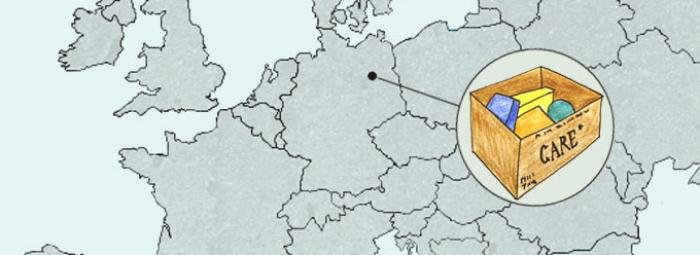
The daily life of children (1948-1949)
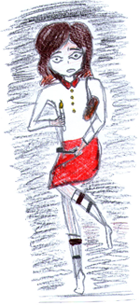 The young reporters from the Böser Wolf (Big Bad Wolf) met some witnesses from the Berlin Airlift who told them about their childhood and described the daily life during this tense phase of the Cold War.
The young reporters from the Böser Wolf (Big Bad Wolf) met some witnesses from the Berlin Airlift who told them about their childhood and described the daily life during this tense phase of the Cold War.
Two hours of electricity per day
The fear of the darkness
I was really afraid of going home in the dark. The streets were only lit on one side. I often had to go up the four floors without any light. I always took my shoes off downstairs and held the keys in my hand, in case someone would have been hidden.
Waiting for the power to come back to prepare the meals
It was complicated for my mother to cook. She had to prepare the food when there was light. It often happened around two in the morning. Then, she would put the stewpot wrapped in newspaper under the bed cover, so that the next day we would have something warm to eat. We could not heat up the food. The coal was rationed, just like many other things. (A witness, girl at the time)
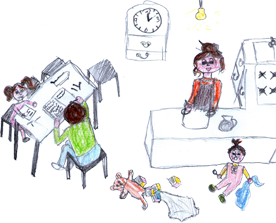 Homework at two in the morning
Homework at two in the morning
In winter, it was dark quite early and we very rarely had electricity. Sometimes, we had some power at two in the morning, so we would get up, I would do my homework, my mum would cook and iron. (A witness, girl at the time)
Gas and electricity were rationed
We could only get a certain amount of gas. There was even a gas meter for that sole purpose. (Mercedes, 7-8 years old at the time)
Coal was rare, and winter was freezing
The joy of being able to bring coal home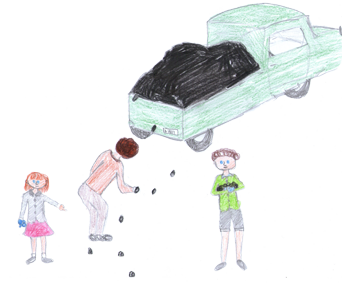
Americans had enormous trucks, semitrailers that they filled with coal. We, children, lived in a street nearby, where there was a big turn. Americans used to drive their vehicles very fast, and us, children would quietly camp there and calmly wait for them to pass. And when the coal would fall off the truck, we went to pick it up. (A witness, girl at the time)
Using a brick as a hot water bottle
We were really really cold. Even the beds were sometimes frozen. As long as the wood-burning stove of the kitchen was still warm, we could put bricks in it. After that, we would wrap them in some paper and took them to bed with us. (Horst, 8 years old at the time)
Windows with broken panes
It was very cold during winter. We tapped some paper in front of the windows. We had a small coal-burning stove, so we were all staying in front of it. All the pieces of coal we could find were burnt. (Mercedes, 7-8 years old at the time)
Food was still an issue
The crisps, all the vegetables were dry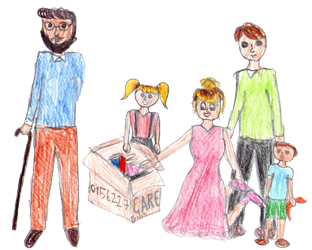 One of the Allies' duties was to give us bread, as well as cakes. And even the Russians did that from the beginning. Right next to our place, there was a baker. He was given flour and yeast at three in the morning. There was also fresh milk for the babies.
One of the Allies' duties was to give us bread, as well as cakes. And even the Russians did that from the beginning. Right next to our place, there was a baker. He was given flour and yeast at three in the morning. There was also fresh milk for the babies.
We also got a CARE package. Inside, there were crisps and vegetables, everything was dry. Otherwise, we were getting ration cards. As neither my mother nor my grandmother could work, we could only get few ration cards. So we were banking on our hens' eggs as we would trade some of them with the butcher. In exchange, he would give us some meat for our cat, we also had to feed it. We had this cat, as well as a parrot, for a long time. They were part of the family.
We, children, were entitled to get an extra portion offered by the Swedish Red Cross. We were given a card with ten tickets on it, which we could use to go eat ten times at the Red Cross' kitchen. But that was only for small children. (Mercedes, 7-8 years old at the time)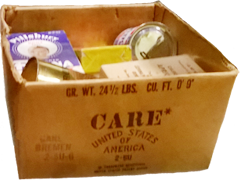
'Some potatoes at midnight'
The children ate more or less their fill. But once, my dad came home very late at night with some potatoes, we all got up and ate the potatoes at midnight. It shows that we were hungry.
There were a lot of things we did not know, so we did not miss them. I must have been 10 years old when I first saw oranges and bananas. (Horst, 8 years old at the time)
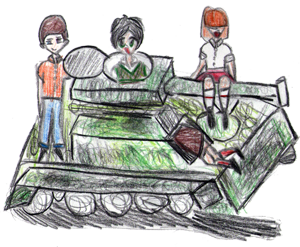 The game made us forget the hunger
The game made us forget the hunger
We were three children. We did not have enough to eat, but oh well, that's the way it was. My mother had to get by, to get organized. So when we were coming back from school and were asking at what time we would eat, she would tell us "Go play outside a bit first". And it is only once we were grownups that she told us she was pushing back mealtime so that we wouldn't get hungry again too quickly. (A witness, girl at the time)
Our playgrounds after the war
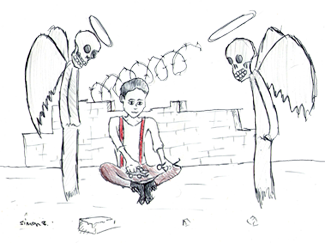 The scavenger hunt
The scavenger hunt
The ruins were our playground, and I always liked climbing everywhere with the others, until one of my classmate died when he fell off. We were gathering scrap iron, and everything that was still worth something. Sometimes we even found some toys that belonged to children who were probably dead. (Mercedes, 7-8 years old at the time))
Some magical places
It was enthralling to meet up and play in the ruins. There was a tank that burnt in the park. We used to play in it. Or in a bomb crater, it was our sandbox. (Horst, 8 years old at the time)
The black market during the blockade
Exchanges that sometimes led to surprises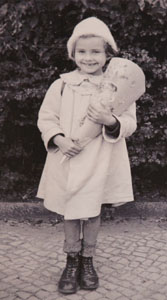 My mother still had some cigarettes from before the war, she traded them against some seeds to feed the hens. Many Berliners had hens or rabbits in their courtyard or on their balcony, so there was also a whole market for that.
My mother still had some cigarettes from before the war, she traded them against some seeds to feed the hens. Many Berliners had hens or rabbits in their courtyard or on their balcony, so there was also a whole market for that.
The black market was not tolerated by the American police, and they were carrying out checks. My mum had exchanged some boots for me in 1947. But there was a police raid, the people had to get into a truck. We were lucky we got to hide in a pharmacy. When my mum opened the bag afterward when we were at home, and we realized that each shoe was a different size. You can still see it on the picture of my first day at school. (Mercedes, 7-8 years old at the time))
Stocking up
My dad used to go in the periphery of Berlin to see farmers in their farms. He was bringing a backpack. Inside, there were items such as watches, jewellery, rugs, everything that could be traded against food. (Horst, 8 years old at the time)
Christmas 1948, a Christmas unlike any other
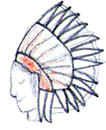 In 1948 we got two Christmas trees. A neighbor brought us one and got something in exchange. Then a farmer came to bring us some food, as well as a Christmas tree. He traded them against some silverware, sheets and tablecloths. That Christmas we also got a goose. It was already dead and it was not plucked. We had to pluck its feathers and take out the oesophagus. We put it to dry and used it as a box for the peas. And a young neighbor used the long feathers to make himself an Indian headdress.
In 1948 we got two Christmas trees. A neighbor brought us one and got something in exchange. Then a farmer came to bring us some food, as well as a Christmas tree. He traded them against some silverware, sheets and tablecloths. That Christmas we also got a goose. It was already dead and it was not plucked. We had to pluck its feathers and take out the oesophagus. We put it to dry and used it as a box for the peas. And a young neighbor used the long feathers to make himself an Indian headdress. 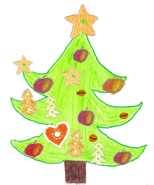 (Mercedes, 7-8 years old at the time)
(Mercedes, 7-8 years old at the time)
There was a Christmas tree and presents. We cooked a hot meal. My mother managed to bake a cake, and this was already a wonderful gift. (Horst, 8 years old at the time)
Interview: Chloé, Dagmara, Elsa, Emmanuelle, Gaïa, Mathilde, Natalia and Rosalie
Drawings: Gaïa, Natalia, Rosalie and Simon
Text, drawings: © Grand méchant loup | Böser Wolf
Photos: CARE-package © Allied Museum in Berlin
Photo: Girl with © Mercedes Wild

